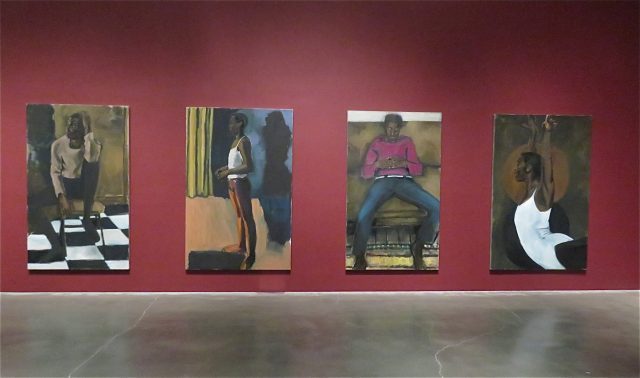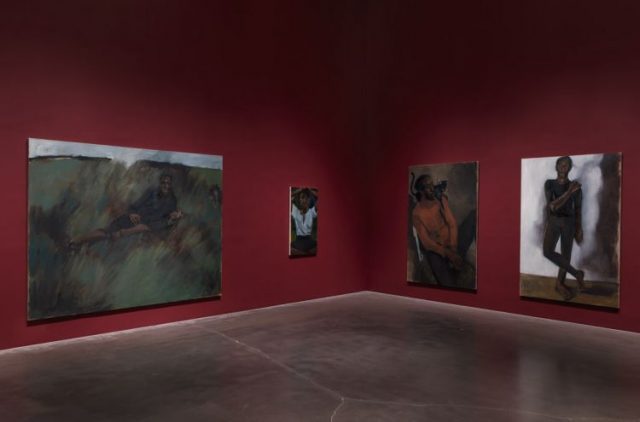
Lynette Yiadom-Boakye’s site-specific “Under-Song for a Cipher” speaks volumes at New Museum (photo by twi-ny/mdr)
New Museum of Contemporary Art
235 Bowery at Prince St.
Through Sunday, September 3, $16
212-219-1222
www.newmuseum.org
Upon entering the fourth floor of the New Museum, visitors join a fascinating gathering already taking place, sixteen figures in stunning canvases, beautifully arranged across three walls as if the black and brown men and women in the paintings are in conversation with one another, the chatter nearly audible, each with a different story to tell. But it turns out that British artist Lynette Yiadom-Boakye’s site-specific “Under-Song for a Cipher,” created specifically for this space, is a completely fictional world. Despite their realistic nature, none of the figures is based on real people; instead, 2013 Turner Prize finalist Yiadom-Boakye, who was born in London in 1977, works from her imagination, making each composite canvas in one day, finishing it before the paint dries (and discarding paintings she doesn’t like). “The term ‘imaginary’ is perhaps a little misleading. It suggests I pull everything out of the air. I don’t,” she tells curators Natalie Bell and Massimiliano Gioni in a catalog interview. “By composite I mean that they’re a combination of different sources: scrapbooks, drawings, photographs, etc. In many ways, I think less about the figures than I do about how they are painted. I ceased to see the paintings as portraits a long time ago. Thus, I don’t really see them as ‘characters’ in the individual sense, as personalities or people with specific traits. I always think of them as somehow beyond these things. They exist entirely in paint.” Yiadom-Boakye, who is of Ghanaian descent and is inspired by such masters as Edgar Degas, Edouard Manet, and Walter Sickert, boasts a bold, firm brushstroke, including just enough abstraction to place her figures in an indefinable time and space, evoking but not specifically referencing art history, in which classic portraiture is heavily associated with white people.

“Lynette Yiadom-Boakye: Under-Song for a Cipher” places paintings in dialogue with one another as well as with viewers at the New Museum (photo by Maris Hutchinson / EPW Studio)
In “Medicine at Playtime,” a man sits on a chair in the middle of a room, the floor composed of black and white square tiles, his left elbow on his knee, his left hand on his head. In “The Much-Vaunted Air,” a woman stands in front of a window, facing off to the left, in a sly way the mirror image of Edward Hopper’s “A Woman in the Sun.” Yiadom-Boakye references Andrew Wyeth’s “Christina’s World” in “8am Cadiz,” but instead of a white girl looking across a grassy yellow field, her back to us, a black man in a green field faces the viewer. The gaze of both the viewer and the figures are central to Yiadom-Boakye’s process; earlier in life, she even considered becoming an optician. In “The Women Watchful,” a tall woman looks through binoculars, as if peering at a painting off to the right, “Of All the Seasons,” in which a woman with penetrating white eyes stares back suspiciously. Yiadom-Boakye, who had her first solo museum show, “Any Number of Preoccupations,” at the Studio Museum in Harlem in 2010-11, is also a voracious writer of essays, poems, and short stories, but she leaves it up to the viewer to determine what tale her figures have to tell, even seeing her titles as another stroke on the canvas rather than an informational description. “It’s all there, thoughts about race, masculinity, femininity, what is to be human and in the world alongside everyone else,” she says in the interview. “But it is complex, joyful, miserable, infuriating, and overwhelming — so not easily put into words. That is why it is painted. The marks, the light, the dark, the color, the composition, the form, the scale: All of these things take on meanings to me, like a language to speak. And beauty is there too, unabashed and brazen.” One of her most unabashed and brazen works is “Light of the Lit Wick,” a lush, sensual depiction of a dancer in a white top and black leggings stretching her torso, arms raised, large light and dark circles on the back wall, mimicking her clothing. It’s a magisterial piece, demanding of extended viewing to absorb its subtle immensity. But don’t get lost in the beauty of the individual canvases, which also include the triptych “Vigil for a Horseman,” of a man in black and red posing on a red-and-white bed. They are in dialogue with one another as much as they are speaking to us. “As I’m working on a painting, I’m looking at and responding to whatever else is hanging near it in the studio,” Yiadom-Boakye tells Bell and Gioni. “That’s inevitable. It’s an immersive process with precious little logical planning, but plenty of magic, rumination, and deviation. Madness can take on a logic of its own sometimes.” It would be madness to miss this ecstatic show, one of the most involving and dynamic of the year.